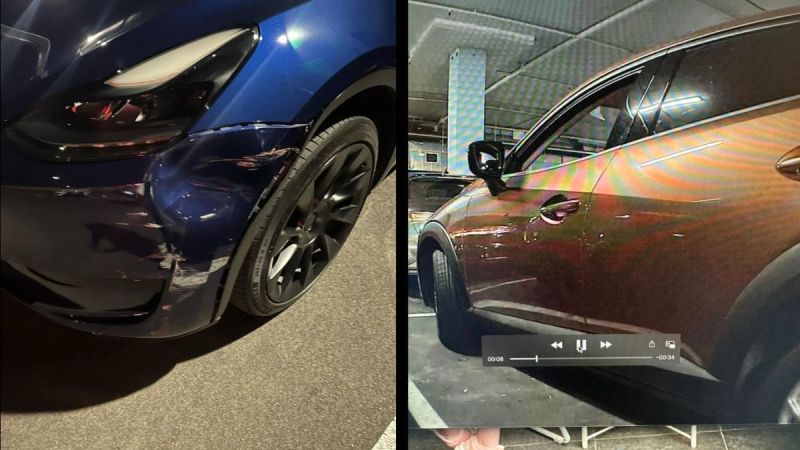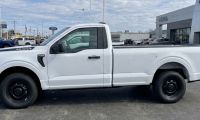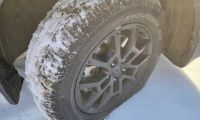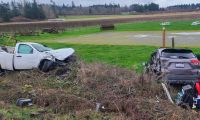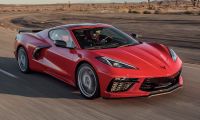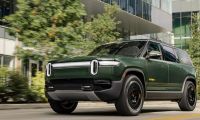There’s something deeply frustrating about doing everything right like parking carefully, owning a car packed with the latest safety tech, and still finding yourself at the mercy of someone else’s carelessness. That’s exactly what I came across in a post from a Tesla owner named Luke Chater in the "Tesla Owners Australia" Facebook group. He had parked his Tesla as part of what should have been a normal weekend outing, only to come back and discover that his car had been hit. The driver responsible had already disappeared, leaving no note, no contact details, nothing. A hit and run. Here's Luke's own words:
"Good morning all. This green P player smashed my car at Westfield Parramatta on Sunday afternoon. I’ve got footage but have been unable to get the rego (plates) from any of the videos. Does anyone have the skillset to identify the number plate in the video attached? It’s the last few seconds. White and black plate but I can’t make out the rego. Any help would be appreciated. I know it’s a stretch but that section of the car park doesn’t have cameras, so security is being difficult and not sure what cut through I’ll get from the police. Thank you in advance."
Here's the picture of the car getting caught in the act:
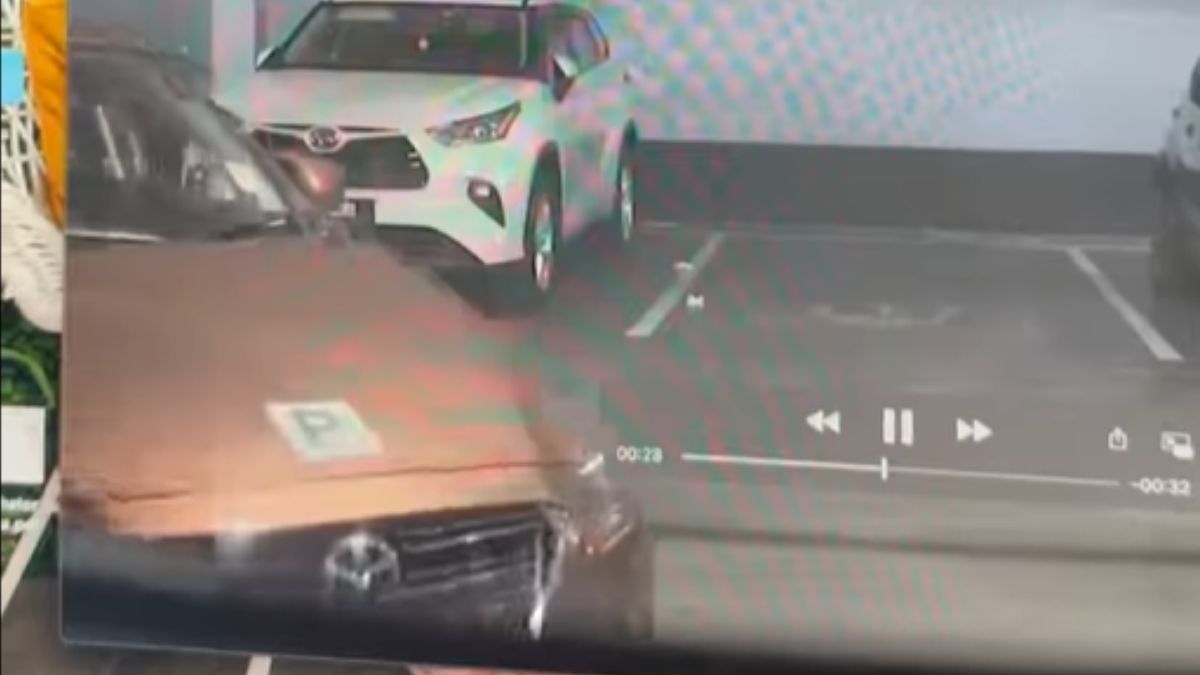
When Cameras Catch the Moment But Not the Details
If you’ve ever returned to your parked car only to find damage that wasn’t there before, you’ll understand the gut punch Luke must have felt. What makes this situation especially frustrating is that his Tesla did capture the moment on video but just partially. The incident was recorded but the license plate wasn’t clear. Such a bummer. The clip cuts in too late and the image quality isn’t good enough to make out the registration number which must feel horrible. That video clip is now Luke’s only hope, and he’s reached out to the broader community hoping that someone with the right tools or skills can clean up the footage just enough to reveal who was behind the wheel.
I actually just recently wrote about another story where a Tesla owner caught someone keying their car in a parking lot, banking on Sentry Mode to be enough to identify the culprit. These systems are incredibly helpful but only when the conditions are just right.
Tesla Owners Share Their Own Experiences
Other Tesla owners chimed in to support Luke and share their own experiences. Jannette Cass-Dunbar recalled a similar challenge, writing:
“We had trouble getting the plates after being t-boned until we used an app called Pot Player on desktop which let us slow down frame by frame a lot better than the standard Windows Media apps. Police accepted the result to contact the other party, which insurance then accepted.”
This might be a decent angle at a solution for this. Tools like Pot Player can be an attempt when trying to extract every last detail from limited footage.
Another voice, David Litchfield, pointed out a lesson that many Tesla owners have learned the hard way:
“A bit annoying, but parking face first is the only way to get the best footage in these cars.”
It’s the kind of tip that seems obvious only after something goes wrong. Tesla’s front cameras tend to offer the clearest resolution and widest view, which can be crucial in moments like these.
JrCadoy Dulaca echoed the same thing, saying:
“That's why when you park, make sure you go front end first, not reversed.”
Clearly this detail could be the difference between capturing a license plate or losing a lead. I bet Luke will only park face first after hearing these two!
One comment that stood out for its similarity came from Ishiie Ilagan:
“Exact same damage and location as mine. It happened at Rossmore Vet but didn't get recorded.”
Whether it’s coincidence or part of a troubling trend, this highlights just how common and discouraging these incidents have become.
Then came a particularly clever observation by Simon Xwn:
"They would have gone through the license plate recognition system to exit.”
In many parking structures, license plates are scanned on entry and exit. But unless police or security are willing to cooperate, that information can be difficult, if not impossible, to access.
More Than Just a Hit and Run
For many drivers that get a clean plate shot and move forward with an insurance claim, there are many others stuck in limbo just like Luke. This isn’t just about one hit-and-run as it’s about a larger reality we’re seeing more and more often as people rely heavily on Tesla’s cameras for peace of mind.
The disappointing reality is that even the best technology can let you down in the wrong conditions. While many Tesla owners report satisfaction even after driving 50,000 miles or more, these moments are reminders that camera-based safety doesn’t always translate into real-world accountability.
There’s a growing number of drivers, including those transitioning from decades-old gas cars, who place great trust in what Tesla’s systems can do. And for the most part they do deliver. But when it comes to parking lot justice, there seems to still be some gaps.
Some owners after long-term use, choose to move on. One example that comes to mind is a driver who traded their high-mileage Model 3 for a Rivian R1T, not because of the vehicle itself, but because they were ready for a new experience after hitting a limit on what the system could do for them.
Where This Leaves Us in a World Full of Cameras
Stories like Luke’s keep showing up again and again in the EV world I’m constantly reminded of how reliant we’ve all become on our tech to protect us. The problem is that technology doesn’t always align with reality. Our cars might record everything but that doesn’t guarantee a resolution when something bad happens.
I'm not saying that the tech isn't useful, as if it wasn't for the slight footage we got, there would be no leads or implications of who this criminal might be. But regardless of that, the gaps exist in practicality.
What's actually more surprising is how the support systems in place like parking lot security, management, even law enforcement, fail to help, especially when there’s no crystal-clear evidence. It reveals a deeper flaw in how we've structured our expectations. It seems as if the promise of always-on surveillance has led us to rely more on machines than on the people or systems supposedly tasked with keeping us safe. Now I don't know if security could've done much here, but I feel like it's shocking how there are no cameras or signs to pinpoint what is going inside of a busy parking lot like this.
Key Takeaways
- If you drive a Tesla, consider parking head-in whenever possible. The front camera generally captures the clearest footage and could be your best shot at catching any incidents.
- Explore third-party video tools. Apps like Pot Player allow frame-by-frame analysis, which might be the only way to extract legible details from blurry footage.
- Ask about entry and exit camera systems. Even if your car didn’t catch the plate, there’s a chance the parking facility did. Sometimes this data could be accessible with the right pressure.
- Never underestimate how helpful other Tesla owners can be. The online community is full of people with advice, tech know-how, and empathy from having been through similar experiences.
- Understand the limits of tech. Tesla’s features are impressive, but they’re not foolproof. The angle, lighting, and camera position all play major roles in whether your footage is actually useful.
What’s Your Story?
Have you ever come back to your parked car and found damage that no one took responsibility for? Did your Tesla, or any recording system, actually help you catch who did it?
I'd love to hear your stories in the comments section below.
Aram Krajekian is a young automotive journalist bringing a fresh perspective to his coverage of the evolving automotive landscape. Follow Aram on X and LinkedIn for daily news coverage about cars.
Image Sources: Luke Chater's post from the "Tesla Owners Australia" public Facebook group.


